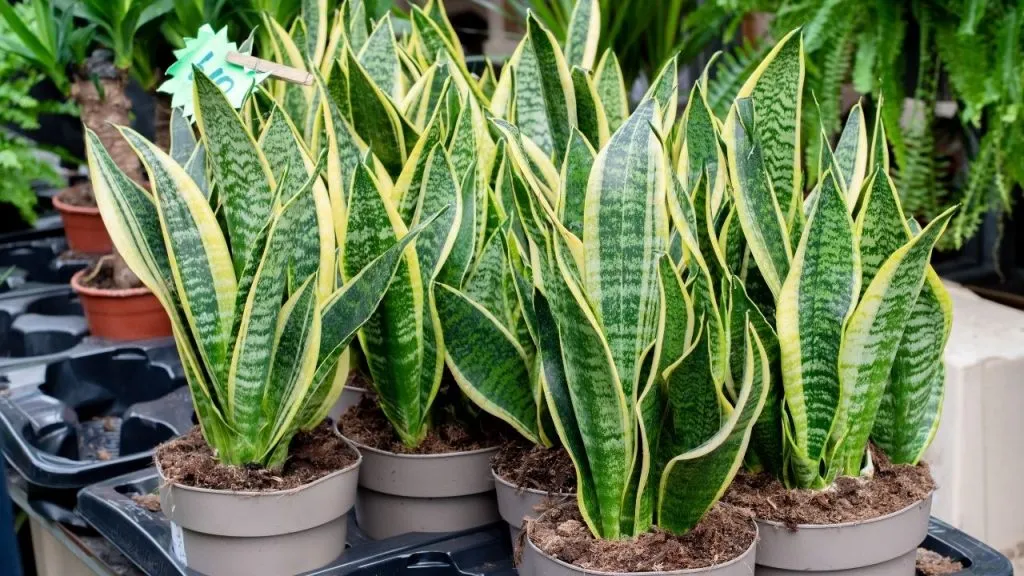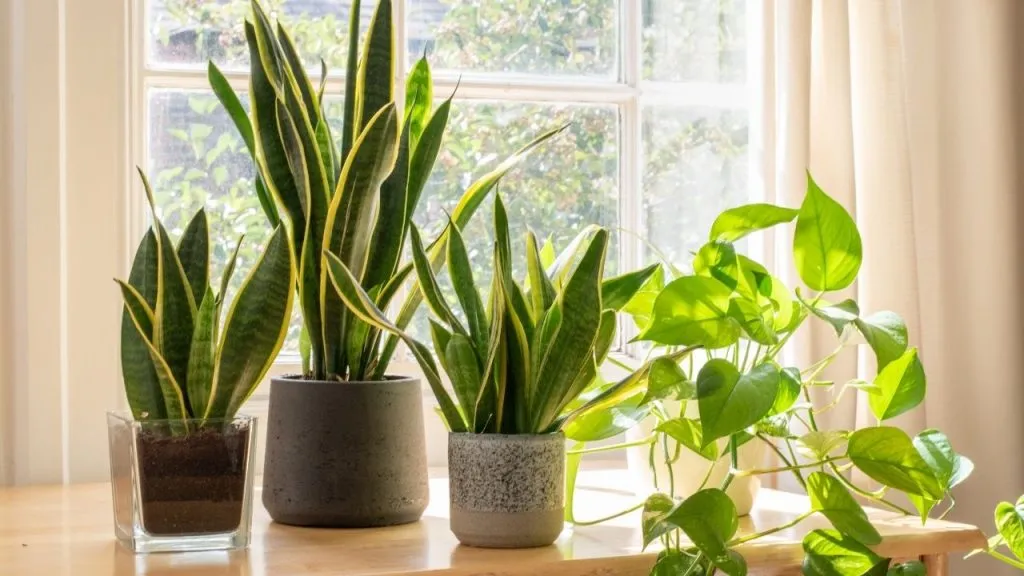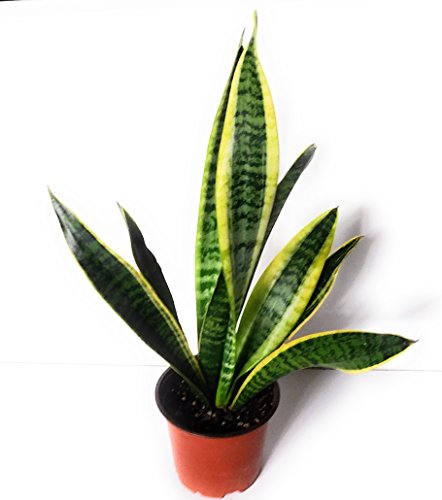Caring for a snake plant is not too complicated but there are some things you need to take care of. Continue reading to find out more.
Also known as Sansevieria and Dracaena trifasciata, a snake plant is a wonderful houseplant to grow because of its fuss-free needs.
Snake plants also are considered auspicious in feng shui. Check Feng Shui Snake Plant Benefits and Placement Tips.
This succulent plant can be identified by its sword-like, stiff leaves, giving it the name “Mother-in-Law’s Tongue.”

Snake plants can come in various colors, but they commonly have green leaves with a yellow border. They make perfect starter plants since they are almost indestructible.
However, keep in mind that snake plants are not safe for dogs and cats just like lemongrass, so if you have pets, plant the snake plant at a spot that is unreachable.
Generally, these plants thrive in bright light but can also be placed in dark corners of the house. If you want your snake plant to grow fast, increase its exposure to sunlight and watch how quickly it spreads its leaves!
In this article, we will discuss How to Care for a Snake Plant effectively.
Snake plant growing season
Every year, around late summer or early fall, snakeskins will start to grow on the root systems of snake plants. This growth is a sign that the snake plant is ready to flower.
The flowers are bright red and yellow and are typically produced in late summer or early fall.
There are many different types of snakes, but all of them grow plants.
- The Snake Plant Growing Season is here! With a cool, dry climate, the Snake Plant Growing Season offers the perfect opportunity for new snake plants to grow.
- When temperatures reach the 30s and 40s Fahrenheit, snake plants will start growing.
- If you live in a warm climate or have a humid environment, your snake plant will not thrive.
- However, if you have a cool and dry climate like we do in Tucson AZ, your snake plant will be able to grow and prosper.
If you are looking for an easy way to get some new snake plants growing, look no further than our local nursery. You can check a wide variety of snake plants that can be grown in any climate.
How to Care for a Snake Plant
| Snake Plant Care Requirements | |
| Light | Give them direct light and sunny conditions |
| Soil | Well-drained potting mix |
| Fertilizer | Mild cactus fertilizer |
| Water | Let the soil dry before watering |
| Humidity & Temperature | Warm temperature (above 50 degrees Celsius) |
Since snake plants are difficult to kill, they are perfect for beginners learning to grow plants. You can grow a snake plant in a container or tabletop or even on the floor.
These plants grow best in warm weather, so if you live in a cold region, it is best not to attempt to grow a snake plant.
Moreover, even though snake plants are drought-resistant, they will develop root rot if overwatered.
Hence, it is vital that you check for dry soil and only then water this plant.
Click below to buy the live plants.
During the winter season, snake plants can survive without water for two months. However, in the summer months, you need to water them every two weeks.
Here are the basics of caring for a snake plant at home:
1. Light
Snake plants need steady but direct light to thrive.
These fuss-free plants can adapt to sunny conditions but can also grow in areas that are dimly lit. However, your plant will grow slowly in a shady corner around the house.
We recommend against shifting the plant from a dim spot to direct light too soon as this can shock your snake plant and make it difficult for it to adjust.
If you want to move the plant from a dimly lit location to a brighter one, start by slowly exposing it to bright light over the duration of two weeks.
Moreover, continue adjusting the plant’s watering schedule accordingly- when placed in a bright, warm area, the plant will require more water.
Anything above 10 degrees Celsius is considered a warm spot for these plants but in the winter, make sure to move the plants so that they are not kept close to frosty windows.
2. Soil
Snake plants grow well in potting mix that is well-drained. Hence, we recommend planting it in sandier soil.
Look for a potting mix that has low peat content. Even though peat is great for plants, it does not allow too much aeration and can cause poor drainage or dehydration issues.
Cactus potting soil works best. Useful resources on gardening soil.
- Soil Degradation Causes, Effects
- Add Nitrogen To Soil Naturally
- How Do You Fix Too Much Nitrogen In Soil
- How Long Does Garden Soil Last
- How To Add Calcium To Soil
- How To Sterilize Soil For Plants
3. Fertilizer
When your snake plant is growing, it is okay to nourish it with some mild cactus fertilizer. You can also use a slow-release liquid fertilizer as long as you dilute it, so it is half as strong.
However, do not fertilize snake plants during the winter months. This is one of the most critical steps in caring for a snake plant.
4. Water
Since snake plants do not require too much water to grow, allowing the soil to dry between each watering is important.
Snake plants and other succulents tend to be overwatered, and eventually, they develop soggy soil and root rot.
Here are some watering practices that will help you grow your snake plant well:
- If you are not sure when to water your plant, don’t just look at the top base of the soil. Instead, take a wooden chopstick and stick it a couple of inches into the soil. If you find wet soil or moisture sticking to the chopstick, do not water the plant.
- Moreover, start watering from the bottom of the pot. This allows roots to grow deep and downward, allowing thick leaves to grow on the plant.
- Keep in mind that snake plants do not grow much during the winter so they do not need as much water as they would during the spring and summer months.
5. Humidity and Temperature
Snake plants prefer warm temperatures and will deteriorate when placed in areas below 50 degrees Celsius.
If you have placed your snake plant close to a window, make sure to switch positions as winter arrives, as you do not want to keep the plant close to a frosty window for too long.
Anything lower than 70 to 80 degrees Fahrenheit will kill the snake plant.
6. Pruning
The best way to boost new growth in snake plants is by cutting off any damaged and mature leaves using a sharp knife.
- You can also use sterile pruning shears or scissors to carefully get rid of the leaves growing at the soil line.
- It is recommended to prune snake plants in the spring or summer, as this is when the plants are actively growing.
- You can choose to prune them in the cold weather, but keep in mind that pruning stresses out a plant.
- In case your snake plant grows too tall, and you need to reduce its height, all you have to do is carefully break off the tallest leaves.
This might be painful for plant lovers, but removing leaves will only allow the plant to become healthier as it encourages new growth.
7. Propagation
Snake plants should only be propagated in the spring or summer when they are actively growing. If your plant is a minimum of four inches tall, you can repot and divide it if you need.
Moreover, new shoots can also grow from the soil, which will need to be potted in another pot. Propagating snake plants through cuttings is another viable option.
Here is how to propagate a snake plant using either method:
- Keep a knife, potting soil, and a clean pot handy.
- Start pulling the root ball out of the old snake plant’s pot and put the flat on a steady surface. Use your hand to gently clear the soil stuck to the roots.
- Divide your snake plant into sections with the help of a knife. However, make sure that the roots remain intact. Don’t worry about cutting through the plant, as this will not cause it to die.
- Prepare a clean pot with cactus potting soil and replant the new sections of the plant into it.
- Water the plant and put it in a sunny area.
8. Growing Snake Plants from Seeds
Even though you can definitely grow snake plants using seeds, propagation is a quicker, more hassle-free method since the seeds of this plant have low rates of germination.
This means that it could take three to six weeks for you to see a seedling.
If you are growing the plant using a seed, here are some instructions to follow:
- Take some starting mix and sprinkle the plant seeds on top.
- Put the pot in an area that receives lots of light.
- Cover it with plastic wrap to increase humidity levels.
- When a seedling starts to grow, get rid of the plastic wrap.
- Remember that the soil needs to be kept moist, but it should not be soggy while the germination is taking place.
- When the seedling is three or four inches tall, you can repot it.
How do I know if my snake plant is happy?
If you observe your snake plant during its growth and development, you can tell that it is happy.
- When the root system is strong and well-developed, the plant appears healthy and thriving.
- However, if the roots are weak or nonexistent, the plant will likely be in a poor state.
- If you notice that your snake plant is not proceeding at its usual pace or 62% of the time, it means that there is a lack of nourishment and support.
- If this happens often or for an extended period of time, it’s likely that your Snake Plant is not being properly nourished.
- You can address this issue by providing enough water and nutrients to keep your plants alive and thriving.
Additionally, make sure to change light frequency every week in order to simulate natural sunlight on your plants.
- Another experiment to check if your plant is happy can experiment with different light and water combinations.
- You can also try putting a container of water in the sun for a short period of time to see if the plant likes being bathed in sunlight.
Caring for Snake Plants: Common Issues
Even though snake parts are easy to maintain, they do not tolerate overwatering.
In fact, overwatering can lead to root rot and fungal infections that may destroy your plant if you are not careful.
Caring for snake plants is not easy, but here are some signs that your plant is dealing with root rot:
Snake plants are common issues in home gardeners, and they can be a real menace to your plants if left unchecked. Here are some tips on how to keep your snake plants in check:
1. Bad Smell
Does your plant have a foul smell coming from its roots?
Take some soil out of the pot and bring it close to your nose. If it smells bad, you are dealing with root rot.
If you save the root system, your plant may survive.
2. Brown Leaves
Happy snake plants have green leaves with yellow or silver streaks.
Brown or yellow leaves are a sign of overwatering, root rot, or pests.
To help your plant become healthy again, change up its watering schedule.
3. Insects
Snakes can carry both Diptera and Coleoptera (a type of beetle) along with them when they move.
These insects can be a problem for those who want to grow snake plants in areas where they might be attracted to light or those who want to control the population of these pests.
4. Weevils
Weevils are serious pests for many types of crops, but they’re especially vulnerable to snakes.
They love to lay their eggs on the leaves of plants, so sedation or destruction of these eggs is key to preventing weevil populations from increasing.
Snake Plant Quick Fixes
–Drain regularly and regularly check for water loss. If you notice any changes in water levels, make sure to adjust the irrigation system or change the snake plant’s placement.
-Be sure to mow their tall stems regularly as they can become a hazard to your plants. Leaving them too long unmowed can lead to root damage and death.
–Train your snakes to turn away from flowers and other fruits if they come into contact with them. This will help keep them from pollinating the flowers, which could harm your plants.
Where should I place a snake plant in my house?

There are a few things to consider when placed in regards to where to place a snake plant in your home.
- Firstly, size is important when it comes to plants; small plants will not take up as much space as larger ones.
- Secondly, placement should be such that the plant can rear its head out of the soil and overlook any potential enemies or predators that may reside in the area.
- Finally, snakes generally prefer bright light and indirect sunlight so placing a snake plant near these conditions is sure to give it the necessary nutrients and light exposure it needs.
FAQs about Snake Plants
Q: Are Snake Plants Easy To Keep At Home?
Snake plants do not require much maintenance or care, making them perfect for beginner growers.
Q: When Will My Snake Plant Grow?
Snake plants are slow growers, but if you grow them in the summer outdoors, they will grow more quickly.
Q: What Is The Average Lifespan Of A Snake Plant?
Snake plants have an average lifespan of five to ten years.
Conclusion
Snake plants are beautiful house plants that clean the air and get rid of any toxins, especially formaldehyde.
They are easy to grow and maintain and do not require too much maintenance.
All you have to do is ensure you do not overwater your snake plant, as these plants develop root rot quickly.
Moreover, keep this plant away from any pets you may have at home, as it is toxic. In case your pet eats the plant and feels sick, take it to the vet as soon as possible.

My name is Olivia, and I live in the United States and love having plants in my garden. Lots of plants are there on my balcony, indoor and outdoor garden also. Here I am trying to share useful gardening tips, how to grow and care for various plants, etc.

